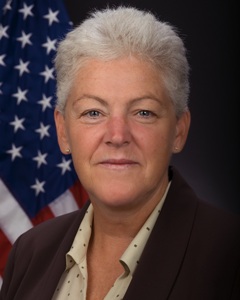 In a speech this morning to students at Georgetown University School of Public Policy, EPA Administrator Gina McCarthy said there was an economic need to act on climate change.
In a speech this morning to students at Georgetown University School of Public Policy, EPA Administrator Gina McCarthy said there was an economic need to act on climate change.
From McCarthy’s remarks:
Before I talk a bit about our energy and environmental future, let’s take a look at a lesson from the past. Most of you won’t remember this as I do, but in the 60’s, industries and business were growing. Suburbs were sprawling up and the automobile was a symbol of the American dream - “a chicken in every pot and a car in every driveway.” The auto industry set the pace of the American economy.
Unfortunately, also in the 60’s, our rivers were burning, future Superfund sites were popping up all over, smokestacks were spewing black soot, and cars were fueled by leaded gasoline. All the progress was great but folks began to realize that it came at too high a cost. Sure, leaded gasoline was affordable and reliable; but its full cost didn’t show up at the pump.
Leaded gas
Toxic leaded gas fumes and other pollutants choked our cities, impairing public health. Lead fumes even threatened brain development in our children. The, quote, “price of progress” proved too much to pay. Millions of people demanded cleaner fuel for their cars, and EPA responded. Despite special-interests disputing the science and the costs, EPA phased out leaded gas. Since EPA was created more than 40 years ago, technological innovations like catalytic converters, have allowed us to drive cars that run 99 percent cleaner.
That same success story of science and innovation has been repeated over and over, as we have tackled our environmental challenges in ways that have sparked American ingenuity and led to a U.S. environmental technology industry that's second to none. If there is one lesson we've learned by now, it’s that real economic progress, and real energy progress, need never come at the price of economic growth or protecting our wellbeing; it comes from investing in cleaner, more efficient technologies that keep people healthy.
The most complex challenge we've ever faced
Today, climate change is the most complex energy and environmental challenge we’ve ever faced. But like we always have, we can turn our challenge into a tremendous opportunity to invigorate the way we make and use energy. Under president Obama’s leadership, EPA is seizing that opportunity. And just like before, despite the naysayers and special interests, people get it. They know that the cost of climate inaction is too high. They know we can, and we must, make energy clean, efficient, and affordable.
Cheap and Clean
The research from David and Stephen’s new book, “Cheap and Clean”, underscores that truth. They say don’t judge a book by its cover, but frankly, the title says it all.
When we talk about energy being cheap, we’re talking about cost of energy on our monthly bills. But when we talk about energy being clean, that doesn’t mean we stop talking about costs. Clean energy isn’t just about protecting public health, it’s also about protecting people’s pocketbooks. That’s a point I want to make clear: clean energy means less pollution, and less pollution means lower costs to our health and economy. Those costs are not always line-itemed on our bills, but they are real nevertheless. As temperatures and seas rise, so do insurance premiums, food prices, medical bills, and more. And taxpayers and businesses pay the price.
Carbon pollution
The American people understand that fact. From all the recent public opinion work out there on climate change, what stands out to me is this: first, people overwhelmingly consider climate change a problem,and they want action. And second, what’s even more impressive, is the overwhelming support specifically for EPA action to curb carbon pollution from power plants.
Just like with our cars, the public sentiment that our energy should be clean and affordable is not new. The good news is, history shows it’s a challenge we’ve successfully faced time and time again: Over the last 40 years, we’ve cut air pollution by 70 percent while our economy tripled in size. And we did it without skyrocketing energy costs. And today, even though we have commonsense standards to regulate mercury and arsenic, there are currently no limits on the harmful carbon pollution fueling climate change.
That’s why president Obama directed EPA to act. A month ago at the UN climate summit, president Obama said, quote, “We cannot condemn our children to a future beyond their capacity to repair…not when we have the means to begin repairing it right now.” He’s right. We can do this. EPA's clean power plan is a commonsense path forward to make the power sector cleaner, while keeping energy affordable and reliable. We’ve had well over 1 million comments on our plan already. And we extended the comment period through December 1st, because we want every good idea on the table.
Clean Power Plan
Our clean power plan will cut carbon pollution from our power sector 30 percent by 2030. When we cut carbon pollution, we reduce other harmful pollutants that cause smog and soot. From those reductions alone, every dollar we invest through the Clean Power Plan will return $7 dollars in health benefits. In 2030, total climate and health benefits could reach up to $93 billion dollars. And here’s the thing, the energy efficiency measures our plan helps put in place by 2030, will actually make energy bills 8 percent cheaper.
It’s easy to see why climate action makes sense. The energy landscape is changing. EPA’s plan looks at where we are today, and maps out where we’re going. We want to raise the common denominator for cleaner, affordable power across all states. And our plan is not a one-size-fits-all prescription, it boosts progress already underway in companies, city halls, and state capitals across the nation.
38 states already have renewable energy portfolio standards. And 10 states already have market based greenhouse gas emissions reduction programs. Clean energy is getting cheaper by the minute. The price of utility-scale solar power is almost 60 percent below where analysts predicted it would be. And between 2012 and 2013, just one year, the price of solar power installed on homes or local businesses dropped 12 to 15 percent. And according to a report from the Carbon Disclosure Project, companies like Delta, Google and Disney use an internal carbon price in their business decisions because investors and CEO’s see the value of climate action.
Flexibility for states
The key to making our Clean Power Plan ambitious and achievable, is flexibility. Flexibility means states can choose the low-carbon path that makes sense to them based on their own energy needs and their own economic vision. Flexibility means more choices for them, and more ways to invest. Our plan sends a powerful market signal that will unleash innovation and create jobs. And that innovation will lead to even more affordable clean power. It’s a positive cycle that we should do everything we can to encourage.
I was recently at a clean tech incubator in L.A.; those companies are growing and creating jobs thanks to more market certainty. That’s the real prize of any regulatory action. We don’t regulate to drive regulation, we regulate to drive markets.
Decades ago, when American cities were choked by smog, we knew we had the technology to begin to fix the problem, and we knew American ingenuity would carry us forward. And it has. All we needed was to nudge the market in the right direction to embrace cleaner energy, and to run with it. And that’s exactly what happened. We sent up a signal flare by making good policy to protect public health. That signal drove markets, drove innovation, cleaned up our cars, and served as a model for the world.
And because we took action, our kids won’t grow up breathing toxic leaded gas fumes. We can, and must, take on climate change the same way. Acting on climate change is not just a responsibility we must accept for the sake of our children; it’s an opportunity we should seize, to retool and resurge with new technologies, new industries, and new jobs.
This is our new catalytic-converter-moment. As we work to build a cleaner, low-carbon energy future—let’s remind ourselves what we’re capable of.



